Thrips, storm beasts, heat beasts !
Also known as "storm bugs" or "heat bugs", thrips are insects that can be seen in large numbers as soon as the hot weather returns. They wander around on your bare skin (face, arms, legs, etc) and can be particularly annoying. Thrips are harmless, of course, but as they are always in colonies, they quickly become exasperating. A black plague that comes back every year to spoil our naps. In this dossier, you'll find a range of answers and products to help you combat this insect, which is becoming more and more prevalent every year during the summer months.
|
I would like to |
|---|
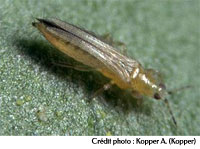
Scientific names : Frankliniella occidentalis, Heliothrips haemorrhoidalis, Thrips tabaci, Echinothrips americanus.
Order : Thysanoptera
Family : Thripidae
Adult size : 1 to 2 millimetres long
Location : Garden
Period : summer
What you need to know about thrips
With over 3,000 species, thrips form an order of their own: the thysanoptera. Each of these species is particularly fond of a particular type of plant, including rose thrips, peach thrips, pea thrips, onion thrips and cereal thrips.
Although some species are effective predatory allies in certain cases, most are crop pests. The Californian thrips, one of the most feared, arrived from across the Atlantic at the end of the 1980s. Very virulent in glasshouses, it also attacks many flowers in the garden, as well as tomatoes, cucumbers, aubergines, beans... and many fruit trees.
Thrips are really very small insects (1 or 2 millimetres long), discreet and polyphagous (their diet consists of feeding on a variety of foods), which makes them difficult to observe and control. They are generally light yellow, dark brown or black and have a striated body. They have elongated bodies and wings edged with long, fine bristles.

For a very long time, it was thought that these insects appeared in summer when the air became charged with static electricity, i.e. during stormier weather (hence their nickname, storm beetles). In fact, this is not the case: the appearance of these swarms of insects is due to the heat, but also to the harvest.
They like crops and, inevitably, your garden. They can number up to 2 million per square kilometre. No wonder they're everywhere. They sting plant organs to feed on the cell contents. The emptied cells then fill with air, resulting in silvery-grey spots or mottles.
They can be found in the air, travelling with the wind, or forming round swarms circling above our heads, ready to land on our sensitive, tanned skin. Silent, you can't hear them coming. They often end up returning to your home, as they take up residence on you. Thrips are usually females, and as they don't need males to reproduce, this explains their impressive numbers.
The development cycle of thrips
The metamorphosis of thrips is intermediate between incomplete and complete. Their life cycle usually comprises six stages of development: egg, larva (two stages), "pre-pupa" and "pupa" (pseudo-pupal stages) then adult.
- Eggs : kidney-shaped and relatively large compared to the size of the female.
- Larvae : resemble adults, but are smaller and apterous (wingless). They are often cream in colour.
- « Pre-pupae and pupae » : resemble adults. Pre-pupae have atrophied wings. Nymphs have more developed wings and long, backward-curved antennae. Organisms in these two stages do not feed and are generally immobile.
- Adults : They measure 1 to 2 mm in length and look like grains of rice. They are generally yellow, brown, black or white. Males are usually smaller than females. Thrips have little flight, but their two pairs of feathery wings allow them to be carried long distances by the wind. Some species are apterous. Thrips have sucking mouthparts.
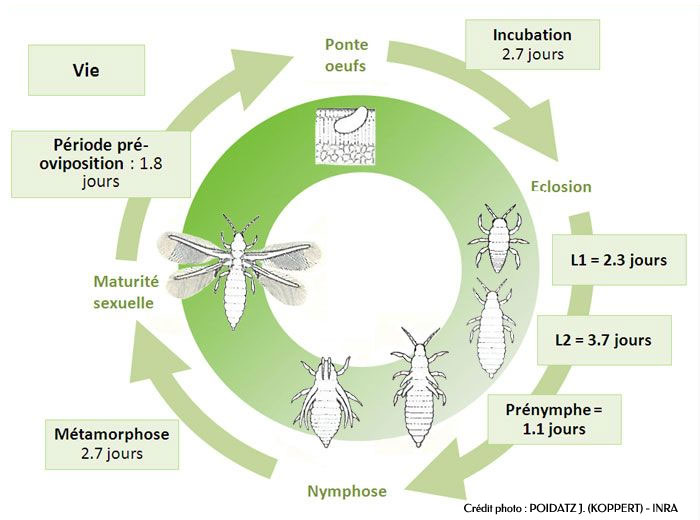
Thrips can reproduce sexually, but mainly by parthenogenesis (asexually).
Females can lay 150 to 300 eggs during their short lifespan (30 to 45 days). In most species, the female inserts her eggs into plant tissue (leaves, flowers, petioles, tender stems, buds and fruit) using her ovipositor (egg-laying organ). Species without an ovipositor lay their eggs on the surface of the plant. Incubation lasts between 2 and 8 days. The young larva (1st larval stage) feeds for a short time before undergoing its first moult. At the end of the second larval stage, it stops feeding, drops to the ground and burrows in. It then transforms into a "pre-pupa", then a "pupa" before becoming an adult. Some species spend their entire development cycle on the host plant.
Depending on the species, thrips (often only females) may overwinter in adult or immature form in plant debris, under the bark of trees and shrubs, in the soil or between the scales of stored bulbs.
The length of the thrips life cycle varies according to species and temperature. The warmer the climate, the shorter the cycle. In general, the insect completes its cycle in 2 or 3 weeks. There are several generations per year.
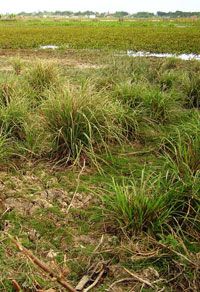
Symptoms of thrips attack
Thrips often attack under cover, as they develop more rapidly when temperatures are warm and humidity low.
Their presence is often noticed by the damage they cause to plants. Thanks to their biting-sucking mouth cone, they empty the epidermal cells of their contents, filling them with air and causing silvery discolouration. When bitten, thrips inject saliva, which is toxic, leading to necrosis of the affected parts, particularly the flower petals. Their presence can also be seen in the tiny black dots that represent thrips droppings.
Thrips are also capable of transmitting viruses, and will develop whole necroses on adult plants.
In general, thrips prefer plants with fine petals, but there are many exceptions. Here are the plants they prefer :
- Indoor garden : Cyclamen, azalea, begonia, croton, ficus crassula, datura, dieffenbachia, fuchsia, hibiscus, orchid, yucca...
- Vegetable garden : garlic, asparagus, basil, carrot, cherry, cabbage, cucumber, strawberry, raspberry, bean, onion, leek, pear, apple, pepper, pea, potato, tomato, vine...
- In the ornamental garden : Aster, chrysanthemum, dahlia, gladiolus, daylily, iris, lily, snapdragon, carnation, pelargonium, petunia, peony, sweet pea, verbena, zinnia, birch, maple, hydrangea, rose, willow, lime, privet.
Factors favouring their presence :
- High temperatures
- Low humidity
- The presence of weeds
Thrips often settle in the hair and can quickly take hold, creating a permanent and very unpleasant irritation. On oiled skin or when you're sweating, they're particularly fond of settling, and you'll inevitably get an itch. As soon as you squash a few, they come back in large numbers.
In this case, the solution is to go home and take a shower. This will eradicate them immediately.
You can also protect yourself effectively against thrips with 3 of our products.
1 - One is to be applied to your skin : either our anti-insect lotion spray for the skin, or our anti-insect Roller. Made with eucalyptus citriodora, these body lotions will keep most insects at bay for several hours.
2 - The other is to be applied to your textiles : our Textile Insect Repellent. Containing geraniol, this spray will deter insects from clinging to your clothes for long hours.
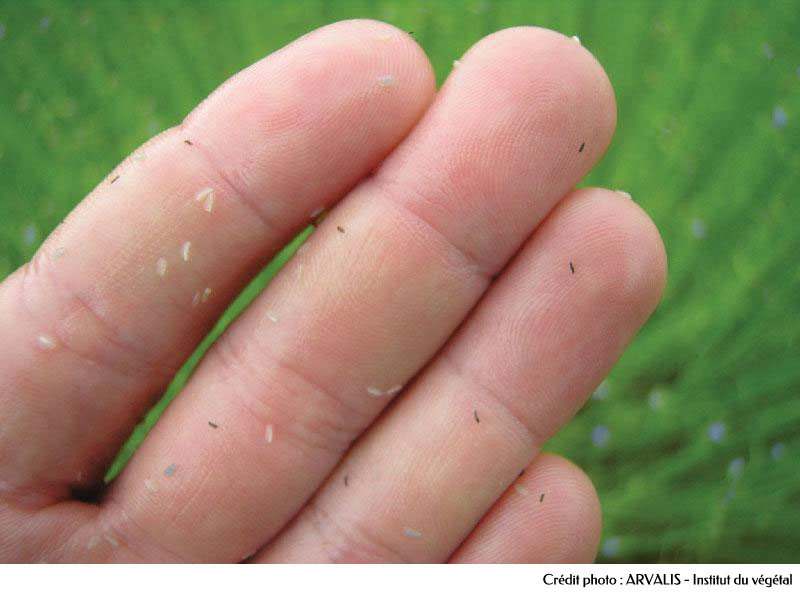
Certain essential oils are powerful in protecting against thrips. These include essential oils of lavender, mint or eucalyptus and, of course, citronella. At the same time, you'll be protecting yourself from mosquitoes !
Everything you need to enjoy a sunny walk or family picnic without the worry of thrips.
How can I get rid of thrips in my home ?
Thrips are phytophagous insects, which means they feed on plants. So getting rid of them at home is fairly straightforward. If you take them all out, they won't be able to find any more food, so there's no point in keeping them there. Especially as some of them may be infested.
But that's not enough, as thrips seek tranquillity and warmth above all else. You need to find the source that attracts them, if it's not your plants. It could be a video screen (have you ever noticed them on your computer screen ?), a picture frame, etc. This is also the case if your wallpaper has been pasted with natural glue. Once you've found the source of the heat, try to limit it as much as possible.
How can I get rid of thrips in my garden ?
To check that they have attacked your plants, look under the leaves: if it's sticky to the touch or you have small black dots, thrips are present. These insects can be difficult to eradicate, and you'll need to be patient and conscientious in monitoring affected plants, but there are several solutions to help you combat thrips.
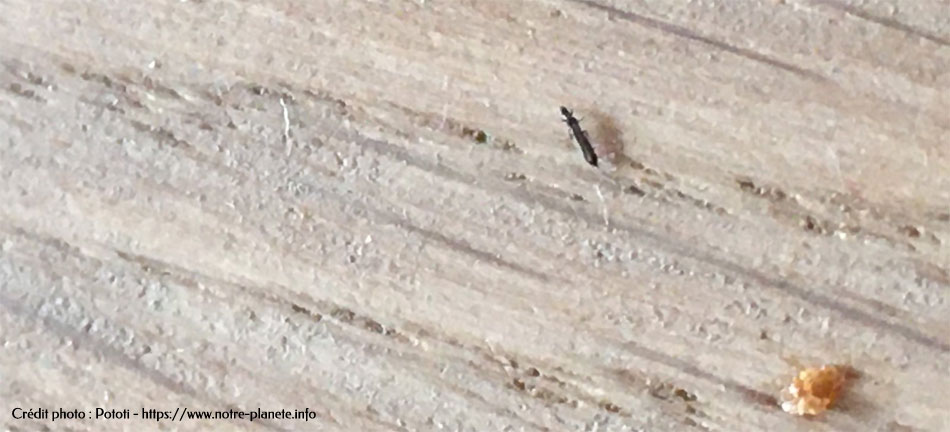
1. Mechanical control
As with red spider mites, prevention is based on a simple principle : keep moist !
Thrips do not develop when there is sufficient humidity. From May and throughout the summer, in hot, dry weather, regularly spraying the foliage of plants not susceptible to fungal diseases may be enough to prevent invasions. For indoor plants (with non-fluffy leaves) and greenhouse plants, spray the foliage throughout the year.
Another method : attracted by the colour blue, thrips can also be trapped by blue sticky plates. This method is widely used in glasshouses, but also works outdoors if the trap is well attached. Use one plate every five metres. Note that this solution has no effect on larvae.
2. Biological control
Biological control is an effective solution, but it will be necessary to determine precisely which species are present in order to find the right response. Not all insects are harmful to plants. On the contrary, some are our allies in the fight against pests!
So it's vital to think carefully when you come across an insect, and to learn to recognise auxiliary insects at all stages of their lives to avoid making errors of judgement.
The most common is the use of predatory mites such as Amblyseius swirskii, Amblydromalus limonicus and Neoseiulus cucumeris (predator of thrips eggs and larvae). These different beneficial insects should be used depending on the growing conditions, but "nursery" bags are still the most suitable technique indoors because they are easy to set up and last for several weeks. Orius predatory bugs and lacewing larvae can be used as alternatives, but are sometimes not very effective for home growers.
On the other hand, the use of nematodes (Steinernema feltiae), a natural predator of thrips, should only be used if the thrips species identified is actually completing part of its cycle in the substrate. This is not the case for all species. As for replacing the entire substrate, this is often excessive indoors, as it causes additional stress for the plant and has no effect if the insect in question does not enter the soil.
Ladybirds, green lacewings, Orius bugs and mites. You can use them in your garden to combat thrips without any counter-indications. A good idea might be to create insect hotels in your garden to attract them.
Certain auxiliary plants can also play an important role in controlling thrips. These include ornamental and common tobacco, marigold, campanula and sago grass.
3. Chemical control
Several of our insecticide products can help you in the fight against this insect.
Diatomaceous earth : This is an effective natural product for getting rid of a large number of pests, including thrips. It's very easy to use, just sprinkle it wherever thrips have settled. Repeat the operation regularly.
4J insecticide : As a last resort, you can treat with our 4J small insect insecticide (diluted to 1.5%). If you have a large number of plants to treat, use the same product in its concentrated form, with you doing the dilution (990 ml of water + 10 ml of pure 4J). Note that this product, based on plant pyrethrum, is short-lasting. It will therefore be effective for rapid curative action, but not for long-term curative action. As soon as the insect comes into contact with the 4J product, it will die instantly (pyrethrum's neurotoxic effect).
N.B.: As this product is not approved for use in gardens, we can only recommend it for use on houseplants, window boxes or window boxes. And do not use this product in a dilution higher than 1.5% or 2%. The foliage of your plants could otherwise burn under the effect of the pyrethrum.
Make your own natural insecticide : a natural insecticide made by mixing a decoction of garlic and black soap. Place 10 cloves of garlic in 5 litres of boiling water. Leave to infuse for at least half a day. Strain the mixture. Add 2 tablespoons of liquid black soap. Spray the plants with this mixture for three days. Repeat five days later.
Spray your plants once or twice a week for as many weeks as you need.
Here's what the Californian thrips larva looks like in motion







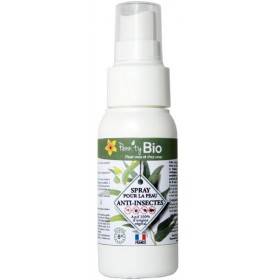
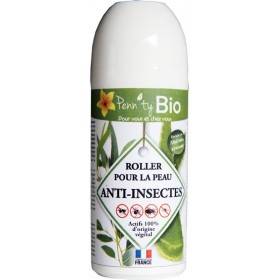
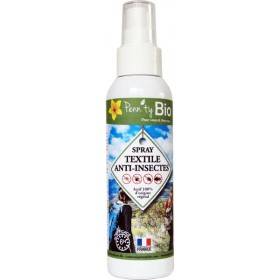
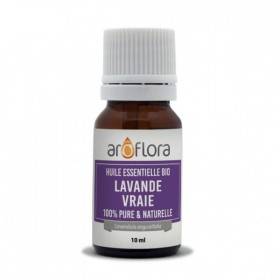
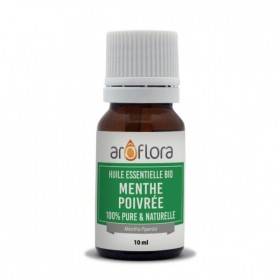
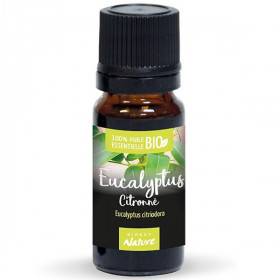
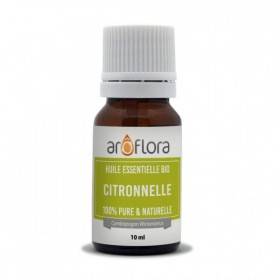
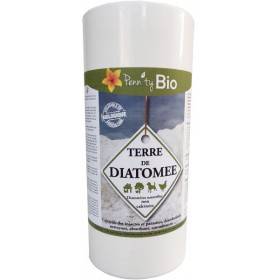
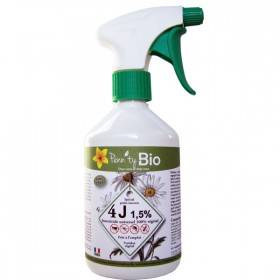

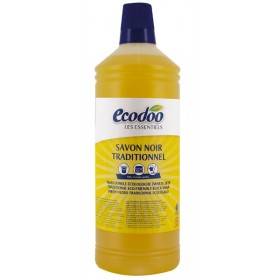
Customer reviews
Commande bien reçue. Je suis tout à fait satisfaite. A bientôt.
Tania
Toujours parfait, livraison, emballage, délai et gentil petit mot personnel pour me remercier de ma fidélité.
XX
Livraison rapide et bien emballé. Petit message manuscrit qui fait plaisir :)
xx
Commande facile, livraison impeccable et produits fiables. Merci.
Isabelle
Explication, commentaire et livraison en un temps record, tout était parfait, même le petit mot de remerciement écrit à la main ! Merci beaucoup
Monique S.
Maryse
produit parfait.
René
Les produits achetés sur le site sont de très bonnes qualités, et j'ai été très bien conseillée. Je recommande !
Aurore
Un grand merci pour cette commande envoyée très rapidement. Je recommanderais votre site
Elise
excellent.
XX
Rapide, sérieux, très bien emballé, un sans faute.Merci.
L.H.
Penn' Ty Bio, c'est ma référence depuis 10 ans au moins. Je ne commande mes produits de toilette et d'entretien que chez eux. Les marques et le service est irréprochable.
GAELLE
Service rapide et efficace. Bons produits
XX
merci pour le suivi de ma commande et les mails par lesquels vous m'avez tenu informée.
Zoé
J'ai été TRES bien conseillée lors du contact. Produit naturel donc c'est parfait.
Lilla
Service très réactif, emballage soigné , livraison rapide. <br /> Rien à redire . Continuez !!
Sophie
Personne disponible, de très bon conseil suite à des punaises de lits dans mon habitation, les produits sont efficaces car depuis aucune punaises et la vie à repris son cours ... merci pour tout
Nathalie
Très satisfaite des délais, les produits sont bien emballés et le petit mot sympathique est fort agréable!<br />
Sylvana
THIERRY
Franchement, Penn'ty bio, c'est top ♥<br /> Quentin est super réactif, de très bons conseils. Encore merci de votre efficacité.
Hélios ☼♥
Très satisfait du site livraison rapide.<br />
Michel
Produits de bonne qualité, naturels et efficaces, expédition rapide et bien emballée, sav très rapide suite à une erreur de ma part,
XX
Tout à fait satisfait de la qualité de la livraison ainsi que du produit commandé.
Régis
J’ai découvert cette société en faisant une recherche sur Internet pour trouver un insecticide contre les sclérodermes. Je ne peux pas encore juger l’efficacité de chacun des produits par contre je suis très satisfait de la rapidité et de la qualité d’expédition, ainsi que du sérieux de la société. J’ai même reçu un petit échantillon est un mot personnalisé j’ai trouvé ça très sympa! Merci beaucoup et bonne continuation pour votre société que je recommande déjà.
BJ79
Très bonne adresse où l'on trouve des alternative aux produits chimiques notamment contre les insectes. Le service client est également de très bons conseils.
ck
Modèle conforme bien emballé délai respecter continuer comme ça parfait.
Carlos
Livraison toujours rapide. J'ai expérimentée le service après vente qui à été excellent avec une réparation rapide et sans frais. Je recommande vivement Penn'Ty bio
Nadine
J'ai passé ma première commande, chez vous il y a trois jours à peine et ce matin, je reçois mon colis.
Sophie
Après 2 traitements à 3 jours d'intervalle, j'ai réussi à éradiquer toutes les punaises de mon canapé. Produit hyper efficace que je recommande vivement.
Emmanuelle
Produits utilisés depuis très longtemps, toujours la même qualité ! Je recommande, les délais de livraison sont très courts, produits très efficaces.
Laurence
Service clientèle très réactif en cas de difficultés. Livraison rapide. Emballage des produits fragiles excellent. Maison sérieuse, je recommande.
Marie
Une utilisation de vos produits a suffit pour nous débarrasser des poissons d'argent. Merci.
Matthieu
Je vous remercie pour vos services. C'est très agréable d'être informé de la sorte.
Anthony
livraison tip top tant en temps et en qualité.
XX
C'est la deuxième fois que je commande sur ce site. J'ai découvert qu'il existait des verreries aux dimensions différentes. Mon diffuseur étant ancien, j'ai chercher le modèle le plus adapté et j'ai trouvé! Mon diffuseur fonctionne à nouveau
Christiane D.
Fidèle à votre marque, je tenais par ce mail à vous féliciter vous et votre équipe pour votre longévité. Votre marque est toujours gage de qualité et sérieux.
Céline
Je suis cliente depuis de nombreuses années. Toujours satisfaite du site, des produits et de la livraison.
martine O.
Sav rapide et disponible. Au top
Severine
Jean-Yves
Merci à Penn'Ty Bio pour la qualité des produits, la réactivité de l’Équipe et le petit mot attentif qui accompagne les colis. Votre site est précieux !!
Veronique B.
C'est vraiment magnifique et ce cadeau a plu, je commanderais pour Noël.
Martine
fiable et de bonne qualité pour les services et les produits :)
XX
Cliente depuis plusieurs années, j'apprécie toujours ce site. Meilleures salutations.
France
sérieux
XX
Parfait.
Philippe
Produits conformes aux descriptifs. Délai de livraison respecté. Satisfaite du nébuliseur qui est superbe.
VR
Infestés de puces de parquet, le produit a agi en moins de 24 heures. Livrés en tout autant de temps. Le seul produit qui ait fonctionné et en plus archi cool pour la nature.
Nicolas
Jean Claude
Commande et livraison rapides!<br /> Rien à dire, c'est parfait !
Christine
Site internet complet, beau et facile d'utilisation<br /> Commande complète et correcte.<br /> Commande emballée a la perfection avec du matériel recyclable, compostable<br /> Délai d'envoi respecté même a l'étranger (Pays-Bas)<br /> Mention spécial pour le petit mot personnalisé ++<br /> On sait pourquoi on commande chez Penntybio depuis 10ans :)<br /> Bonne continuation
Jennifer A.
Bons produits conformes à mes attentes et livraison au top. Je recommande vivement.
Chantal P.
Très bons produits je les recommande.<br /> Merci à Pennt'ty Bio pour tout, aussi bien pour les commandes et les emballages.<br /> Bravo Pennt'ty Bio.
Bernadette G.
livraison impeccable, produit bien emballé et correspondant au descriptif, excepté pour la surface de diffusion, ma salle principale doit faire 25m2 maximum et ça ne se diffuse pas au-delà.
Pascale
BIEN,CONTINUEZ COMME çà.
XX
Ma commande s'est déroulée sans aucun problème avec une livraison rapide et soignée. La satisfaction est au rendez-vs ! Continuez ainsi ! Merci et cordialement !
Etoile 07
Super produits, envoi rapide et soigné, conseils et échanges courtois ! Une jolie boutique en ligne pour acheter en toute confiance ! <br />
Patricia
Bon produit. Merci Penn'Ty Bio. Un seul passage dilué à 5% et les puces ont disparus. Il en restait deux ou trois qui ont dû se perchés pendant le traitement mais sinon c'est performant.
Axel
J’ai bien reçu le nouveau diffuseur fonctionnel après essai et je vous remercie pour votre confiance et votre rapidité sur le traitement de mon problème. Ce n’est pas tous les jours que l’on voit un SAV aussi efficace !
Florent
Impeccable.
Christine
Diffuseurs qui sortent vraiment de l'ordinaire, un envoi parfait - merci BCP
Anthony
Livraison très rapide. Bravo pour la réactivité
François
Merci et bravo pour la qualité des produits et du service toujours aussi efficace et performant.
Annick P.
Bonjour, j’apprécie depuis longtemps votre travail : la qualité de vos informations et des produits que vous vendez.
Frederic
Très bien, je recommande cette boutique
Salomé
Je vous remercie de votre professionnalisme et de votre réactivité.C'est loin d'être toujours le cas lorsque l'on commande sur internet.
Gaëlle
Site intéressant proposant de bons produits, attractifs et respectant la nature. Le regret c'est le prix de certains articles.<br />
Catherine
Je tenais à vous remercier pour la commande que je viens de recevoir ce matin. Merci beaucoup et je n'hésiterai pas à recommander sur votre site.
Sandrine
Très réactifs entre la commande et la livraison. Je suis toujours satisfaite de mes commandes soigneusement emballées !
France L B
Pour ma part j'ai été satisfaite de la réalisation de ma commande et du délai de livraison. Je recommande votre société.
Nelly
Sav très réactif et efficace suite à avarie durant transport. La livraison du produit en remplacement du colis défectueux à été particulièrement rapide. Merci.
Valérie
Livraison efficace et bon contact oral avec mon interlocutrice.
Maussane
Livraison très rapide et colis emballé soigneusement.Site à recommander.
isabelle d.
Merci à Penn'ty bio d'avoir garder beaucoup de produits de la marque Lerutan et pour le sérieux dans la préparation et l'expédition des colis. Je recommande.
SR
Site de grande qualité !
Rose Anne Marie
C'est extrêmement délicat de votre part d'avoir fait diligence. Je ne manquerai pas de recommander votre site et de souligner votre gentillesse. Encore merci
Michel
Ravie de découvrir un site qui présente des produits de qualité avec une vraie démarche éco responsable à des tarifs intéressants.
XX
Produit performant et raisonnable au niveau prix. Je recommande
XX
Très satisfaite. Merci.
CM
yvette
Excellent article sur les diffuseurs d'huile essentielles ! grâce à lui j'ai pu faire mon choix basé sur une excellente analyse de votre part !
Laurence
Tout est parfait à chaque fois. L'attention portée va même jusqu'au petit message, c'est agréable. Fidèle aux produits et au site plus que jamais.
xx
J'adore ce site qui fait un vrai travail de sélection de produits que je ne trouve pas ailleurs et sur une large gamme. Je recommande.
Veronique G.
2 commandes à mon actif et jamais déçue. Vous avez gagné une cliente régulière :) Merci pour votre sérieux et le contenu bien rempli de votre site ! c'est super d'avoir une description hyper détaillée de chaque produit.
clara
Envoi rapide et soigné. Emballage ecoresponsable. Je suis ravi d’avoir trouvé des pièces de rechange pour les diffuseurs à huiles essentielles!
Ina L.
je vous remercie pour vos services, c'est très agréable d'être informé de la sorte. colis bien reçu Merci pour la rapidité de la livraison
Bernard
Un grand merci pour la qualité et la rapidité de votre réponse.
Tony
merci de votre disponibilité et amabilité!
Eric
MERCI au personnel à l’emballage !!! Ma dernière commande était super bien emballée. Elle a résisté aux (épouvantables) chocs subis pendant le transport. Merci
Veronique
Correspond à mes attentes
Henry
trés satisfaite de ma commande,( produit, et livraison,rapide ) MERCI
Danièle M.
Site sérieux. Bons produits.
Magali
Bon produit mais frais de port un peu cher.
Marie Paule
Tout est parfait : la qualité des produits, la rapidité d'expédition, la qualité du colis. Je suis enchantée et resterai fidèle à ce site.
Dominique
Merci beaucoup pour votre rapidité et votre professionnalisme.
Julie
Livraison très rapide et produits intacts à l'arrivée grâce à un emballage impeccable.
Etta
Juste un petit mot pour vous remercier du message accompagnant mon colis ! Je croise les doigts pour que les produits marches mais entre-temps, je voulais vous remercier et en profiter pour vous souhaiter à mon tout un joli printemps.
Rose B.G
Merci pour cette première commande, envoyée très rapidement, et dans un petit colis, avec frais de port très raisonnables.
Valérie O.
Grande gentillesse et efficacité : que demander de plus ? Merci !
Chantal M.
Comme d'habitude, envoi soigné, produits performants, Merci.
XX
Service de qualité, suivi rigoureux, et rapidité au rendez-vous. Les produits sont très fidèles à leur description et pour un coût serré. A recommander fortement.
JACKY
Excellent site d'achat. Très rapide et que de bons produits.
James
J'ai découvert ce site en cherchant de la terre de Diatomée. Livraison rapide. Très sérieux. J'ai mis la page dans mes favoris car j'ai repéré d'autres produits.
Isa
Commande bien reçue ! Bien emballée ! ! ! Jolis produits ! Merci !
AYH
bravo pour votre réactivité et la qualité des produits
Annick P.
Un grand merci pour votre professionnalisme et la qualité de vos produits. Longue vie à votre site.
XX
Une boutique en ligne, sympa et très réactive. On apprécie surtout la livraison express. Pas besoin d'être américain pour livrer dans des délais de champion !<br /> <br />
Daniel de Paris
Beaucoup de soins dans la commande reçue. Je recommande!
XX
Bravo pour votre sérieux. Colis reçu très vite et produits impeccables. Belles fêtes de fin d'année
Mat
accueil téléphonique personnalisé réactif compétent et bienveillant, livraison rapide et conforme. BRAVO merci pour la qualité de votre travail
Annick
Très rapide pour la livraison en Belgique et sérieux. Merci<br />
Corinne
Cliente depuis plusieurs années. Super service, réactif, cordial. Les produits sont excellents.
Christine
Très contente des produits de qualités et une commande reçu très rapidement. Merci
PATRICIA A.
Juste ce petit mail pour vous dire que j'ai bien reçu votre colis et que mon patron est enchanté ! Ca embaume les huiles essentielles dans le bureau et... ça ne fait pas de bruit ! Encore un grand merci pour votre gentillesse et votre souplesse commerciale.
Sonia
Produits performants. Très satisfaite de vos services.
XX
Envoi rapide et soigné, produits efficaces et réponse rapide à mes questions. Je recommande.
xx
Efficace rapide et à l'écoute. Diversité des produits. Efficacité des produits. Respect des délais de livraison et prise en compte des spécificités client PMR ( ce n'est pas toujours le cas). Site bien fait pour navigation et produits bien mis en valeur. Des promos et des bons de réduction cumulés en fonction des achats. Merci pour votre efficacité rapidité et professionnalisme.
xxx
Bien, la majeure partie des produits sont efficaces. Je connais cette boutique depuis plusieurs années, je recommande ce site.
XX
Efficacité de la livraison , très rapide . Produits livres en parfait état . Très bien emballés . Merci.
Geneviève
Client depuis des années Produits de qualités et surtout qualité de service.
XX
Un super magasin en ligne, avec plein de produits disponibles.<br /> L'envoi a été très rapide et soigné, avec une très bonne communication à chaque étape. Bref, une adresse à connaitre et à garder ! Merci !
Pab57
Très contente d'avoir découvert ce site internet ! Du conseil jusqu'à l'achat c'est super. J'étais très embêtée après l'apparition de petit insecte chez nous (des anthrenes) et c'est le seule site internet e-boutique qui a pu nous renseigner dessus et enfin indiquer les produits pour les éradiquer sans pour autant nuire à notre santé (mais en respectant les conseils d'utilisation bien sûr). J'ai reçu ma commande rapidement, et avec surprise un petit mot de remerciement personnalisé avec mon nom dessus. Des détails qui au finale font la différence. Un service de qualité rien à dire. Merci !
XX
Première commande chez Penn'Ty Bio : <br /> - navigation sur le site = 5/5<br /> - préparation du colis = 5/5<br /> - Prix compétitifs = 4/5<br /> - Qualité des produits sélectionnés = 5/5<br /> <br /> Vendeur à recommander.
Gaëlle
Alex
Noëlle G.
Très bon produit juste ce qu'il faut à prix attractifs Envoi rapide.
xx
Bon produit , envoi rapide.<br /> <br /> <br />
Christine
Je suis très satisfaite de mon échange avec le service client (personne à l'écoute, de bon conseil). Envoi rapide et soigné, avec un petit mot sympathique de l'équipe, le top!
XX
ANNE
Bon choix, bons conseils et service livraison très rapide. J'aime faire mes courses sur ce site.
FDA
J'adore. Très grande diversité de produits, les explications sont simples et complètes.Quand aux colis, ils sont extrèmement bien protéger. Un grand merci.
Nadine
Produits d'excellente qualité, arrivés rapidement, et conformes à leurs descriptions.
Michelle G.
Bon produits et service !
Rose-Marie
Des produits très efficaces quand on suis dans l'ordre le traitement. Un léger petit bémol sur le spray insecticide, si possible essayer de trouver un spray plus puissant et plus large pour une diffusion optimale dans les coin et recoin inaccessible. Sinon tout est nickel est une excellente qualité de résultat.<br /> PS: Il faut prendre tout les produit pour un traitement efficace en foyer privé (maison).
Florian G.
Une entreprise fiable, efficace, de confiance, chez qui je recommande de faire ses achats.
S.
clair net précis. merci
jannick
On ne peut pas toujours faire confiance à des sites de ventes sur le web, mais sur Penn'Tio, j' y viens les yeux fermés. Excellente communication avec le service clientèle, un suivi sérieux. Je remercie chaleureusement toute l' équipe.
Sergine T.
Produit de qualité conforme à mes attentes, envoi rapide et soigné, très bien.
Anne
J'apprécie depuis de nombreuses années la qualité de vos produits et le sérieux de votre site. Une petite mésaventure avec un diffuseur me permet de vous féliciter pour la réactivité de votre SAV. Bravo !
Thierry G.
Avec les trois lettres BIO dans votre nom, je ne m'attendais pas à découvrir des billes de polystyrène comme matériaux de rembourrage. Il y a certainement plus écolo !
Michel D.
Excellent service et livraison rapide. A conseiller pour la santé des animaux (chiens et chats)
MICHEL
Bien reçu. Bravo pour votre extrême rapidité. Merci
Magali
Site pratique, compétent, prix corrects. Un envoi très rapide, et je dirai "parfait".
Greg
Livraison en temps record à l'adresse indiquée en France puis départ dans l'océan indien. Reception des produits en quinze jours à l'autre bout du monde : ravie. Je vous laisserai les avis produits une fois utilisés. Le site est très bien fait et très agréable à utiliser. Le petit mot à la main dans le colis humanise la transaction, je l'ai apprécié. Je pense que vos produits sont très utiles et je vous souhaite une belle réussite et sur la durée.
Sylvie D.
Bons produits. Fonctionnent très bien.
xx
Livraison rapide, emballage plus que parfait, le diffuseur NEOLIA est merveilleux pas bruyant, fonctionnement idéal. Merci PENNTYBIO pour votre sérieux, site web à recommander.
CLAUDE
Livraison rapide et très bien emballé et protégé. Très bonne efficacité. <br /> <br />
XX
L’esprit commerçant de proximité chez un vendeur en ligne !
Philippe
Je suis vraiment très satisfaite de la prestation de ce fournisseur : délai de livraison très rapide et emballage des produits réalisé avec un maximum de soin. Bravo !!
Eliane
Envoi très rapide, personnalisé et soigné. Merci
XX
J'ai bien reçu le colis sans aucun problème. Merci pour la rapidité et le sens du service.
Nicolas
MOI JE DIS INCROYABLE !!!<br /> Plus que mieux d'une rapidité de dingue ! bravo et le colis impeccable surprotégé.<br /> Que toutes les entreprises prennent exemple sur vous. merci
AURELIE A.
Rapidité de livraison. Très bon produits. Merci
Mélina
Excellente réactivité !!! Produit en stock, commandé le 23 dec à 8h30, recu le 24 dec à 9h30. On peut guère mieux faire ! Super communication avec le vendeur.
Xavier
Je viens de recevoir la pastille noire aujourd'hui et je vous remercie de votre envoi gratuit (ce qui est rare de nos jours).
Laurence
en comparaison d'autres produits employés précédemment, je trouve les vôtres beaucoup plus efficaces et cela sur le court terme ,disparitions des odeurs en combinant les produits suivant vos conseils .
XX
interressante. Beaucoup d'articles référencés. Après pour la lutte contre les punaises de lit, je ne suis pas sure de l'efficacité de certains produits. C'est un vrai fléau ces bestioles.
Francelyne D.
Livraison très rapide et produits bien emballés.
Catherine
Toujours impeccable, les produits, les services. Depuis que j'ai changé de facteur, plus de soucis. (Ça n'est arrivé qu'une fois!!!)
XX
Entièrement satisfaite.
Ch. D.
livraison rapide, produit conforme.Prix séduisant.
XX
j'ai reçu mon colis aujourd'hui, merci c'est très rapide et sérieux.
Clara
livraison rapide ,prix raisonnable , produits super efficace j'ai vite calmé mes douleurs lombaires ...enfin soulagée . Merci pennty bio
JEANNINE
Dimanche soir, invasion de vrillettes du pain. Lundi matin, commande en urgence des produits verts adéquats. Mardi, livraison, traitement et fin de l'invasion.
Jean-Pierre
Livraison rapide et petit mot manuscrit joint au colis, vraiment très sympa! Merci et continuez, vous le méritez.
Jean-Pierre
Merci beaucoup pour la rapidité avec laquelle vous m'avez fait parvenir le diffuseur.
Bichette
j'ai reçu mon colis aujourd'hui, merci c'est très rapide et sérieux.
Nathalie
Boutique sérieuse. Commande arrivée très rapidement. Merci pour votre gentil mot avec la facture.<br /> <br /> <br />
I Defoy
Après essais de divers produits, votre insecticide 4J est le seul à être venu à bout des puces ramenées par le chat de la maison. Livraison rapide par chronopost
JEAN MARIE
Merci pour tout le soin que vous mettez pour une livraison individualisée, chaleureuse et aussi peu impactante que possible sur l'environnement !
Sandra
Bravo et merci : produits de qualité et service TOP... continuez !...
XX
Félicitations pour la qualité de votre site & la valeur de ses informations ! Continuez ainsi ! On a besoin de vous !
Ronald
Claudine
Parfait !
Mireille
colis dans les temps,emballage parfait,super accueil téléphonique pour renseignement, je recommande ce site.
ROSCO
Je ne connais pas encore tous les produits mais contente de ce que j'ai commandé. En revanche un peu cher quandmême ce qui me limite.
xxx
Bonjour, je voulais vous féliciter pour la clarté de votre site, la rapidité de la livraison et la qualité de l'emballage.
catherine R.
Après la découverte des punaises de lit dans 2 chambres de notre vieille maison, j'ai trouvé votre site. le dossier m'a été très utile et je suis très contente d'avoir trouvé des produits moins toxiques que ce que proposent les autres sites de vente.<br /> Je vous remercie d'avoir répondu à mon mail car c'est un peu l'affolement quand on découvre chez soi des punaises de lit.
Françoise S.
Commande reçu très correcte, très bon matos, encore merci et bonne continuation.
Dominique et Monique A.
Très bien...merci.
Olivier
Site très réactif livraison rapide le produit Stop tique et puce est parfait sauf le pulvérisateur.
Danielle B.
J'ai été très déçue de ne plus trouver mon déboucheur dans mon biocoop habituel, et perplexe en apprenant qu'il était remplacé par un produit à base de soude...c'est comme ça que je vous ai trouvé sur internet.<br /> Alors merci pour le dépannage, pour le mot gentil qui accompagnait mon colis , et bravo pour le calage en amidon de maïs compostable!<br /> Bravo pour votre démarche et à très bientôt.
Cécile D.
Les produits sont de bonne qualité. Leur prix est raisonnable. Ils sont livrés rapidement, et en bon état.
XX
J'ai bien reçu mes articles et je vous remercie pour la livraison rapide et impeccable !
Françoise
Livraison rapide et soignée. J'utilise les produits bio qui sont de très bonnes qualités. Un savon m'a été envoyée par erreur à la place de celui commandé et il m'a été remplacé très rapidement. Bravo pour leur réactivité. Je recommande fortement ce site.
Liliane
Très bon site avec de très bons produits et un soin particulier apporté à la préparation de chaque commande... De plus, Sophie et Quentin prennent la peine d'écrire un petit mot de remerciement avec la commande envoyée....c'est peu commun mais très sympa....:-)
STEPHANE P.
Cela fait plusieurs fois que je commande chez Penn'Ty Bio et je suis toujours satisfaite de la qualité des produits et de la rapidité d'expédition. Je recommande ce site !
Ghyslaine
Bonjour Monsieur,<br /> Nous nous étions parlés au téléphone il y a quelques années. Bravo pour l'évolution de votre site et vos dossiers instructifs. Vos produits aussi sont très bons. Bonne continuation, bien cordialement.
Marina
Livré hyper vite. Bravo !
Mick
Suite à un précédent message notifiant une erreur de produit à la livraison, Penn'Ty bio m'a fait parvenir à titre gracieux le bon produit. Merci
Martine
Penn'Ty Bio wonderfully served our family in Switzerland so that we could try the range of Totemsavon products, which are such caring, loving, and consciously manifested creations :)<br /> <br /> By allowing a shipment to Switzerland and elsewhere, I am sure so many more people would be able to benefit from the beautifully selected product portfolio in Penn'Ty Bio and all, together, make a conscious leap by using and demanding a way more purer approach to anything we interact with.<br /> <br /> Thank you so so much Penn'Ty Bio!<br /> <br /> In 8 Love We Heart Trust<br /> <br /> Miguel Ángel
Miguel Ángel
Livraison rapide et avec colis préparé avec soin :)
Florian
Je voulais non pas faire une réclamation; mais vous féliciter pour vos produits que j' ai bien reçue, et également pour la rapidité de votre envoi ce qui est plutôt rare dans d'autre site.
Jérôme
Colis parfaitement emballé et produits conformes. 1 des produits était très fragile et est arrivé en excellent état, merci :o) Pourquoi achetez à l'étranger alors qu'on a de si belle s entreprises en France? Tarifs identiques ou moins chers que chez Amazon ;o)
Stéphane C.
je viens de réceptionner ma commande. Tout est ok. Merci pour ces produits respectant l'environnement et l'être vivant.
Anatole
livraison rapide, produits bien enveloppés avec juste un petit bémol : pour l'imperméabilisant dont le couvercle n'était pas bien fermé.
Alain
très bien je recommande.
Sylvie
Bravo ! je vous félicite pour votre efficacité ne manquerai pas de vous conseiller. Merci à la prochaine commande
Anthony
Site très sérieux, de très bons produits et la livraison est rapide.<br />
Isabelle
Après un souci sur l’article livré, le site a fait preuve d’une excellente communication (simple et efficace par sms) qui m’a permis de me faire livrer un 2nd article par la marque très rapidement. Parfait !
Pierre
Content des produits achetés, reçu rapidement et bien emballé. Merci.
XX
Excellents services, très serviable
XX
Site très pratique. Commande aisée. Suivi régulier. Délai de livraison respecté. Colis très soigné. Tout est parfait.
Nicole
Commande reçue rapidement, frais de port raisonnables pour expédition à l'étranger et les produits sélectionnés au top! Merci!
Cédric Adolphe B.
Livraison très rapide. Notice livrée avec les produits ainsi qu un petit mot très agréable. Produits très efficaces, avec de l huile de coude, on en vient à bout. Le produit concentré nous a permis de tout éliminer. Par précaution, nous avons tout de même utiliser le spray. Dans une pièce, nous avons utilisé le fumigène. Pour les animaux, la mousse semble efficace. Dans quelques jours nous ferons le shampooing et plus tard les pipettes. Mais franchement après avoir utilisé d autres marques qui ne fonctionnaient pas, nous sommes ravies et nous recommandons ces produits. Merci
Virginie C.
Excellents produits. Excellent service.
James T
Une grande compétence, Monsieur Dufil est très professionnel et sait soigner ses clients. Quand à la gamme de produits proposés, elle est parfaite et complète.
Alain A.
Très bon site. Envoi rapide. Prix moins cher que sur d autres sites. Bravo et bonne continuation.
Camille
Très satisfaite du produit.Rapidité et emballage très soigné.SERIEUX.
MARLENE
Merci et surtout, continuez, c'est rare de trouver sur internet une relation aussi personnalisée sur un mode aussi agréable.
Sabine
I had a marvelous experience with ordering and everything ! Thank you for a great service.
XX
Excellent!! Commande passée le lundi, reçue le mercredi!!! Les produits sont en plus de super qualité !
MADELINE
Site très sérieux et personnel vraiment agréable. Envoi rapide. C est parfait !
Ingrid
SATISFAITE
ANNE
Je voulais vous remercier +++ pour votre gentillesse et surtout... votre compétence. C'est vraiment de l'excellent travail... j'ai été bluffée :-)<br /> Renseignement téléphonique 10/5 - produit 10/5... encore merci
Maryse
Bonjour, colis bien emballé arrivé sans encombre, démarche écolo bien ancrée et petit mot perso. Merci à l'équipe de Penn'Ty Bio.
Sofi
Commande reçue assez rapidement. Merci pour votre sérieux.
Émilie
Toujours satisfait et pour les prix et pour les produits.
andré a.
Très contente de vos produits.
nathalie G.
Livraison très rapide; Tout était parfaitement emballé. Je referai appel à vous.
JV39
fidèle cliente de Penn'Ty Bio, je ne me fournis que chez eux.
XX
Pas encore essayé le produit, mais le site est très sérieux. Livraison dans un temps éclair, même si je suis en Belgique. Emballage soigné. On peut faire confiance.
Roberta
Parfait! Préparation et expédition de la commande hyper rapides. Emballage très soigné (j'ai acheté un produit fragile). <br /> Je suis très satisfaite!
Elise M.
Client depuis plus de 10ans. Toujours satisfait du matériel propose. Boutique sérieuse prix compétitifs livraisons et suivis rapide.
XX
Les produits commandés sont conformes à mes attentes. Quant à l'accueil au téléphone, il est parfait et nous avons toujours trouvé un terrain d'entente. Je fais confiance à Penntybio.<br /> Merci.
XX
Site intéressant. Je l'ai découvert, en fait. Produits ménager éco-responsable. Bon pour la maison et non agressifs. Merci.
Mydiadao
anne-marie B.
Très bon produit facile en entretenir, pas cher.
XX
Je confirme efficacité sur la préparation et expédition du matériel. un grand merci
Jeremy
Bons produits, emballage impeccable, livraison super rapide ! Parfait !
XX
Jamais déçue : les produits correspondent à la description et sont livrés rapidement.
Mireille
Commande bien reçue;je suis tout à fait satisfaite;à bientôt
Sonia
2 commandes à mon actif et jamais déçue. Vous avez gagné une cliente régulière :) Merci pour votre sérieux et le contenu bien rempli de votre site ! c'est super d'avoir une description hyper détaillée de chaque produit.
Magali
Produit conforme aux attentes.<br /> <br /> <br /> <br />
Alain
Super efficace !!!
xx
Très satisfaite.
Louise
Juste un petit mot pour vous remercier de votre disponibilité et pour vous dire également que je suis très satisfaite des produits que j'ai acheté, ils sont vraiment efficaces.
Barb.
Merci pour vos conseils avisés. Et merci pour vos produits de qualité.
Loïc
Je suis arrivée sur votre site en cherchant un diffuseur que je viens de commander, mais je voudrais vous dire que votre site est très intéressant, bien fait. Vos dossiers sont enrichissants merci
Joelle
j'ai bien reçu la commande et je vous remercie pour votre efficacité.
Margot
J'ai toujours été satisfaite de mes commandes chez Penn'ty bio. Rapide efficace. Surtout les caractéristiques des produits est claire et complète. et le site contient beaucoup d'informations sur les différentes gammes. Merci pour votre travail et votre activité.
XX
Un grand merci pour la qualité et la rapidité de votre réponse.
Simon
J'ai bien reçu le diffuseur et j'en suis très content.
Paul
Envoi rapide, emballage au top, continuez comme ça... :-)
bruno b.
Merci pour votre envoi : rapidité, ponctualité, information de suivi du colis etc. Vraiment du bon boulot.
E.G
C'est ma première commande chez Penn'Ty Bio, et ce ne sera pas la dernière.<br /> J'étais à la recherche d'un nouveau diffuseur d'HE et, après discussion avec Quentin, mon choix s'est arrêté sur l'Elixia (Direct Nature) qui est d'une efficacité redoutable et d'un silence absolument surprenant.<br /> La livraison s'est faite en 72h en point retrait avec un conditionnement hyper sécurisé.<br /> Lors du déballage, j'ai constaté un léger défaut de finition sur la verrerie.<br /> J'en ai fait part à Quentin par texto avec photos à l'appui.<br /> Il m'a aussitôt recontacté pour me proposer un envoi d'une nouvelle verrerie dès que disponible.<br /> Un professionnalisme et un sens du service exemplaires qui font de cette enseigne une valeur sûre.<br /> Penn'Ty Bio est vraiment la boutique en ligne qu'il vous faut connaître.<br /> Je vous la recommande vivement.
Jean-Yves S.
Je suis ravi de trouver les produits de qualité et d ‘efficacité incomparable.
Denitza K.
Site de produits naturels et bio très bien fait, agréable et fiable. beaucoup de produits de qualité.
Anne Marie R.
Françoise
Bon rapport qualité-prix. Envoi rapide et sécurisé !
Chrile
Au fil de mes commandes (j'en suis à la 5 ou 6ème) décidément, du sérieux et de l'écoute ! chaque fois que j'ai eu un petit problème: contact immédiat, réponse immédiate, et tir rectifié illico ! Dans le top 5 de mes sites internet !
Vincent
Service de qualité, suivi rigoureux et rapidité au rendez-vous. Mon colis est arrivé vite même avec un paiement par chèque. Les produits sont très fidèles à leur description et pour un coût serré. A recommander fortement.
Vincent
Pennty bio prends le temps de renseigner et donne de très bons conseils.<br /> Les produits sont emballés soigneusement et la préparation des commandes hyper réactive. Je recommande les yeux fermés !
Mattloumag
Bonjour <br /> C'était ma première commande sur votre site et j'en suis très satisfaite <br /> Je vous remercie pour votre professionnalisme (site, prise de commande, livraison) ainsi que pour le petit mot qui rend le tout humain. Très belle journée.
CG
Toujours très bien et parfaitement emballé ! Merci<br />
Valérie
très bons produits et service commercial très performant, continuez sur cette voie, merci.
Annick
Colis très bien protégé service rapide. Merci. Site très sérieux .
Elios R.
Parfait. Rien à redire. Extrêmement efficace.
Quentin
Tout était parfait. Produit, prix, délai.
Marco
Produits livrés rapidement dans un colis non surdimensionné, les produits sont conformes à la description. Je recommande vivement ce site très bien fait !
Hervé
De très bons conseils, une livraison rapide et des produits de qualité !
Fabienne P.
Merci à tanteOdile pour m’avoir fait découvrir votre site. Depuis je suis une cliente assidue. Très satisfaite de la rapidité des envois, de la qualité de vos produits qui sont par ailleurs très bien détaillés par leur composition et leur mode d’emploi. Une amie vous a rejointe également avec la même satisfaction <br /> Continuez.
Marité D.
Commande reçue rapidement, très bien
XX
Super !
Yann
Livraison ultra rapide, bien emballée. Produits au top. Parfait !
Caty
Excellent service après vente après un problème d acheminement de colis par la Poste. Une relation client de très grande qualité. <br /> Cordialement,<br /> <br />
PV
Très satisfait de Penn'Ty Bio : choix étendu,prix raisonnables délais de livraison rapides.
xx
Louise
Livraison conforme et rapide. Les produits sont emballés dans des emballages recyclables, voire compostables : j'ai beaucoup apprécié. Je recommande ce site.
Patrick
Parfait comme site, commandes faciles à faire et livraison rapide !
Cindy
Satisfaction totale. Entreprise au top. J'ai téléphoné le lundi matin, malgré que les contacts téléphonique ne sont que l'après midi, une personne très charmante m'a rappelé presque aussitôt pour mes donner les infos que je souhaitais connaître sur ma commande. Bravo. nous sommes mercredi et ma commande est arrivée. Encore bravo continuez comme ça.
Jacques M.
Rapide, sérieux et qualité, produit correspondant à la description, très contente, je recommande votre site et vos produits.
Corinne
Marie Aline Roux
Livraison rapide et fiable, dès que le chèque a été reçu. Produits de bonne qualité.
Chantal H.
rien a redire, sauf, le montant des frais de livraison, un peu élevé.
XX
Hélène
Livraison rapide et produit conforme à la description. J'approuve à 100% le principe du recyclage des éléments d'expédition. Un produit fabriqué une fois soit avoir plusieurs vie. Bravo pour cette initiative.
Christophe
Super, envoi rapide,bien protégé et petit cadeau !
xx
J'ai enfin reçu le petit colis, hier. Il a mis un mois pour me parvenir, mais vous n'y êtes absolument pour rien, comme je le pensais, il a été mis de côté lors de la grève nationale. Je vous remercie d'avoir fait faire des recherches, j'ai reçu un mot de la poste.
Hervé
Bon produit, efficace et laisse une odeur plutôt agréable. Expédition rapide, emballé avec soins. Je recommande
Mary
Parfait comme d'habitude
Sylvain
Everything was very nice ! Keep handling your customers likes this!
xxx
1ère commande. Très satisfaite : Colis expédié très rapidement et bien emballé. Merci pour votre sérieux.
Ghyslaine
Nous sommes très satisfaits du service client : mot personnalisé dans le colis, disponibilité du service après-vente... Nous souhaitons à votre société un succès croissant.
Sara
super emballage écolo...bravo !
Isa
Excellent site rapide et efficace. Descriptif intéressant.
XX
Comme toujours service "au top" réactivité, qualité produits... BRAVO et merci pour la qualité de votre travail
Annick
Produit anti puce extrêmement efficace !<br /> Le vendeur a pris une demi-heure de son temps pour m'expliquer absolument tout ce qu'il y avait à savoir sur le produit, de la composition a la mise en œuvre.. Bref au top ! Je recommande donc vivement Penn'ty !
Louis
Client depuis de nombreuses années, je suis satisfait à la fois de la boutique et de pratiquement tous les produits achetés.
Jean-Claude
Très bons produits efficaces.
XX
Totalement satisfait. Les produits sont super efficaces et tout est très bien suivis. Je recommande vivement ce site.
Stéphane N.
super contente, j'y trouve facilement les produits dont j'ai besoin et le service est impeccable et gentil !
Hélène S.
Rapidité, emballage nickel et écologique, mot de remerciements personnalisé, produits au top....j adore....je suis une nouvelle cliente conquise. Un grand merci...
Hélène P.
J'apprécie les services de Penn'ty bio. Un maximum d'étoiles pour eux.
Ch. D.
Mon avis sur penntybio, très bon produit sur ce site pas une gamme monstrueuse mais que du très bon, et pareil pour les livraisons ultra rapides et le excellent sav si besoin. Je recommande vivement. Client depuis 2018 aucun soucis.<br /> <br />
thierry g.
Très satisfaite. Je recommande cette société sérieuse. bon suivi de la commande.
Sandrine
Je tenais à vous remercier pour votre service de qualité, une livraison toujours rapide, des colis bien emballés - qui évitent fuites et casse, ainsi que pour le petit mot personnalisé joint à chaque commande, c'est toujours très agréable.
Isabelle G
Très bon produit, conforme à la description.
MICHELE P.
Très satisfaite par Penn ty bio. En effet, suite à un produit défectueux ( housse matelas) , j'ai aussitôt reçu un bon de retour pour renvoi gratuit en colissimo et ai reçu la nouvelle housse dans les 48 h, avant même le renvoi de la première housse. Merci pour la réactivité et la confiance de cette entreprise.
dominique B.
Je parlerais de vous a mes amies car vos produits sont vraiment excellents. Bien a vous et tous mes remerciements.
Patricia
Colis bien arrivé. Emballage remarquable. Diffuseur très joli, très efficace et peu bruyant avec de la couleur qui change. Très satisfaite de la commande.
Sabrina
service très efficace à chaque fois que j'ai commandé. aucune mauvaise surprise sur la livraison. je recommande
Agnès
Tout était parfait l’envoi la livraison merci beaucoup
XX
Sophie. A
Rien à redire, de la commande à la livraison.
XX
Excellente communication, service très rapide (même à l'étranger), emballage parfait ...
Jacques N., Belgique
Excellentes prestations. Les produits sont formidables, l'emballage aussi. Les délais d'expédition compétitifs. Je recommande vivement Penn'Ty Bio à tous ceux que l'état de la Planète pour les générations futures inquiètent.
XX
Très satisfaite, merci.
Christine
Merci. Je tenais à vous faire part de ma grande satisfaction. Je suis enchantée par les produits et par le service. Salutations et bonne continuation,
Odile
Quel dommage pour le produit manquant, je vous remercie pour le remboursement.
Didier
Merci beaucoup le colis est arrivé à la poste hier et je te retire aujourd'hui Merci pour votre efficacité et votre rapidité
Ingrid
Livraison rapide , produits de qualité, je recommande Penn'Ty Bio.
XX
Très bon site. Navigation facile. Les commandes sont expédiées rapidement comme annoncé. Aucun problème depuis que je suis cliente. Je recommande Penn'ty bio.<br />
Elvyne
Livraison rapide , le tout correspond à mes attentes.
Julie
Bonjour Sophie et Quentin,<br /> Je viens de recevoir ma commande et je tenais à vous remercier pour la rapidité de l'envoi, votre gentil petit mot et le petit présent qui sent bon et donne envie. Bel été à vous deux également
Geneviève
Très bon site, du personnel sérieux et la livraison en temps et en heure. Merci
Marine T
Emballage au top. Livraison rapide et sans dégâts.
xxx
JM
Parfaitement parfait, je ne me fournis que chez Penn'ty bio depuis qu'ils m'ont débarrassée de punaises de lit.<br />
MARIE CLAUDE G.
Je vous remercie beaucoup de m’avoir fait profiter d’un acheminement par Colissimo alors que rien ne vous y obligeait, sauf votre conscience professionnelle, chose rare de nos jours et qu’il ne faut jamais manquer de souligner.
Cécile
J'ai reçu mon colis hier. Merci de vos démarches,
Sam
Efficacité redoutable. enchanté.
Robert
Site clair, envoi rapide, marchandises bien emballées, et un petit mot charmant!
SM
Produits facile à utiliser, efficaces et finalement pas plus onéreux, à l'usage que des produits issus de la pétrochimie. Service livraison impeccable. Je recommande +++<br />
XX
Tout va bien. Bonne année 2021.
Bernadette M.
Service au top !!!<br /> Colis reçu très rapidement avec un petit mot manuscrit me remerciant de ma commande et de la confiance que je leur ai témoigné <br /> Suffisamment rare pour être signalé <br /> Je vous encourage toutes et tous à les soutenir en passant commande chez eux!!!!<br /> Longue vie à Penn’Ty Bio !!!!<br /> Ils le méritent
Pierre-Steph
Très bon site, très sérieux je recommande, produits de qualité et service après vente au top, de plus livraison des plus rapide et produits très bien emballés, tout est parfait
virginie
Commande tout à fait conforme et emballée avec grand soin.
Sarah
Les produits achetés sont excellents. Ils répondent parfaitement à ce que je cherchais. Bravo pour votre site
Michel
Merci d'être à l'écoute pour notre terre et vos clients. Encore une fois je suis très satisfaite de ma commande. Et mes compagnons à 4 pattes sont ravis de se protéger en bio. Merci pour votre attention manuscrite en fin du bon de commande..
Raymonde julie L.
J’ai bien reçu mon colis et vous remercie de votre rapidité. Bravo pour le geste écologique et durable. Emballage nickel ! Et mon chat a adoré jouer avec les billes jaunes !
Anouk
Un diffuseur plus de 80 M², avec huile essentielles eucalyptus, vraiment formidable, on respire mieux et çà sent super bon. Le matin 1 heure, et le soir 2 heures. De jolies couleur, et pour les fêtes une jolie ambiance. Bravo.
PATRICK
Tout est parfait de la commande à la réception. Commander jeudi et reçu samedi. Et très contente de mon achat . Je recommande
Nadege M.
Envoie soigné et rapide.<br /> Merci pour le petit mot à la main.<br /> Très appréciable.
XX
Merci pour l'expédition de la pièce de verrerie qui a été recu cette fois sans casse. Meilleures salutations et à très bientôt sur votre site pour un prochain achat .
Louane
Bon service et bon produits
Odile R
Je suis une amie de vos parents et suis toujours très satisfaite de tous vos produits. Ne changez rien et bonne continuation.
Marité D.
Service très professionnel et très rapide. A conseiller fortement.
Didier M.
colis reçu ce jour, merci pour le flacon offert
Andrée
très bien livraison dans les délais, colis intact, bon produit.
Martine
Super produits accueil plus que parfait gentillesse. Livraison au top merci beaucoup
Christiane
Livraison express. Colis toujours aussi bien préparé (cales, flocons, adhésif sur les bouchons qui risquent de couler). Bravo pour votre professionnalisme.
Isabelle
Hyper cher :: très déçue du prix par rapport à la quantité de produit acheté. Sur le site internet, les flacons semblent grands, or pour 80 euros je me retrouve avec 4 flacons de petits produits insecticides... trop cher
xxx
Bonjour. Je souhaite vous remercier pour votre rapidité. Le colis est arrivé en bon état . Les huiles que nous avons commandées embaument la maison. Ce diffuseur est génial.
Christian
Prix intéressants. Expédition super rapide à bon prix. Et tout ça de façon agréable !
Alexis M.
Très bien !
XX
Contente de voir que d’autres alternatives naturelles aux produits plus nocifs soient proposés. Entreprise sérieuse dont commandes sont très bien honorées. Merci.
Capzoe
Merci pour le geste commercial, et aussi pour les nombreux conseils et l'excellent service client.
Tristan L
Pennty Bio? Einfach genial. Super rapide , bon produits, super service-livraisons. Je vais recommander bientot =)
xxx
Boutique très sérieuse avec un envoie rapide et des produits super efficaces.
XX
Très satisfaite de ma commande. Emballage soigné et envoi rapide. Merci beaucoup pour votre professionnalisme !
Sophie
Vos explications par email ont été très claires et votre diligence dans le traitement de ma commande et de mes demandes est très appréciée.
Henri
Commande reçu en 2 jours, impeccable. Tous les produits emballés avec le plus grand soin, petit mot personnalisé! Et encore un petit savon bio au parfum délicieux comme cadeau!! Merci Penn'Ty Bio !!
Orchidée
Site sérieux, proposant de bons produits, efficaces en particulier sur les punaises de lit, fléau actuel. Merci car entre les produits et les housses de matelas nous avons réussi à les éradiquer dans deux maisons à deux ans d intervalle. <br /> Bravo aussi pour la livraison la plus écologique possible.
L.C
très satisfaite de ma commande site vraiment sérieux livraison soignée et rapide ,les articles sont conformes a la description,je suis enchantée et recommande vivement
Marie Viviane C.
Très bien ! envoi rapide et conforme à ce qui est annoncé.
Jacqueline S.
Toujours aussi "réactif" et efficace<br /> Bravo et merci pour votre professionnalisme.
Annick P.
Un accueil téléphonique très agréable et de très bons conseils. <br /> Merci à vous.
XX
Fiable, et très bons produits , Service après vente efficace et sympathique.
Vilma V.
J'ai bien reçu ce jour, en bon état, les 2 diffuseurs galets. Merci aussi pour votre petit mot manuscrit me souhaitant un bel été. Fidèlement,
Annie
C’est la première fois que je commande sur ce site et pas déçue livraison rapide de ce produit que l’on ne trouve pas partout. Je recommande
Patrick
Merci pour votre sérieux et la réexpédition ultra rapide d'un achat non conforme (dont vous n'étiez pas responsable).
Marc
En cette période d'avant Noël, je craignais que me colis arriverais en retard. 48h après mon achat, c'était dans la boîte aux lettres. Du coup, je suis large pour mettre mon achat sous le sapin. Merci à vous
Art4
comme toujours excellente réactivité, livraison très rapide et qualité produits TOP. Merci pour votre compétence.
Annick P.
J'ai bien reçu ma commande. Com' dab' , rapidité efficacité ...Merci
Sally
Je trouve l'essentiel sur le site à des prix défiants toute concurrence. Continuez comme cela.
XX
Dommage, les vendeurs ne savent pas lire les indications inscrites sur les produits qu'ils vendent
XX
Envoi rapide. Rien a redire.
Marie France
Merci beaucoup pour l'info, c'est rapide chez vous, très appréciable!
Denis
Très satisfaite de ma commande chez Penn'ty bio. Site très détaillé, produit reçu rapidement, message manuscrit très sympathique. Je recommande !
XM
Je voulais juste vous remercier. J ai reçu mon répulsif " lézards" aujourd'hui, un petit mot super gentil joint à ma commande ça fait plaisir. J espère que ça va fonctionner. Bonne journée à vous et merci.
Cynthia
Cliente fidèle depuis plusieurs années, je ne peut que recommander ce site. Tout est parfait. Tous les produits au top, rapidité d’envoi, gentillesse, allez y les yeux fermés vous ne serez jamais déçus.
Marité 06
Vos produits sont de bonnes qualités et les produits très bien emballés
Dominique
Je me permets de vous écrire un petit mot afin de vous dire que votre site est très bien fait.
Tom
Un grand merci pour votre offre et votre professionnalisme. Pour un service en ligne, vous savez vous rendre proche de nous. Bravo et "suerte" !
Pierre M.
Très bons produits, service rapide et de qualité, rapport qualité/prix intéressant. Je recommande vivement.
Alain
La livraison est rapide, je n'ai jamais était déçue de ce site, et les produits sont pas chers et de très bonne qualité!
Patricia
J'ai reçu le colis, merci beaucoup de votre promptitude et bonne continuation.
Louise
Super, livraison rapide, suivi très rigoureux, site de confiance, très sérieux à recommander... Merci pour tout.
Bernard
Très bien , bon produits, La prochaine commande avec plaisir, livraison très rapide.<br />
Rainer
Les produits ont été très appréciés par la destinataire. <br /> De plus quand on pose une question, on a toujours une réponse, un conseil très rapidement. Merci pour votre réactivité
xxx
Marie-Noëlle
merci pour votre professionnalisme. Merci pour les produits envoyés dans de bons délais. Merci pour la qualité de vos produits
Marcelle
Commande bien reçue . Je suis très satisfaite Merci pour votre sérieux
LILIANE
Bon site, fiable, rapide et efficace.
Leo L.
Bonjour Sophie & QUENTIN, Merci pour votre petit mot. . . . Ça fait chaud au Cœur de voir qu'il y a encore des Gens Comme VOUS sur cette planète ! Le monde devient de plus en FOU ! ! ! Cordialement.
Dominique T.
Rapidité de traitement et petit mot avec le colis très appréciable.
XX
Un plaisir de recevoir les colis soignés et respectueux de la planète de Penn’Ty Bio. Merci
k.
Commande passée le jeudi soir, colis livré chez mon "commerçant-relais" le samedi matin. Quelle rapidité ! Du vrai professionnalisme !
Emeline
Parfait ! Envoi rapide et produits de qualité. Merci pour le petit mot. Je suis très satisfaite !<br />
Julieanaïs
Efficace, livraison rapide.<br /> <br />
H
Merci pour votre efficacité et votre gentillesse, commande, livraison, petit mot agréable, tout était parfait !
Sylvie
Merci pour votre démarche si respectueux de l’humain, des animaux et de l’environnement !
A.F
Excellent site. Très à l'écoute. Livraison rapide. Problème avec un piège à guêpes un autre m'a été livré très rapidement. Chapeau et très agréable de tomber sur des gens compétents.<br /> Encore merci.
XX
Service rapide et efficace. Et Sympathique ! toujours un petit mot, ça fait la différence. Et c'est français en plus :). Je recommande.
XX
Envoi très rapide et bravo pour votre site de reconnaissance des insectes nuisibles.
Brice
Merci pour votre geste que j’apprécie.<br /> Cela fait plaisir de retrouver l’esprit commerçant de proximité chez un vendeur en ligne. Je surveillerai attentivement cette nouvelle livraison.
Philippe
Livraison rapide. Produits bien emballés.
Bruno
Bravo ! je vous félicite pour votre efficacité et ne manquerai pas de vous conseiller.
Nicolas
Leave a review | See all